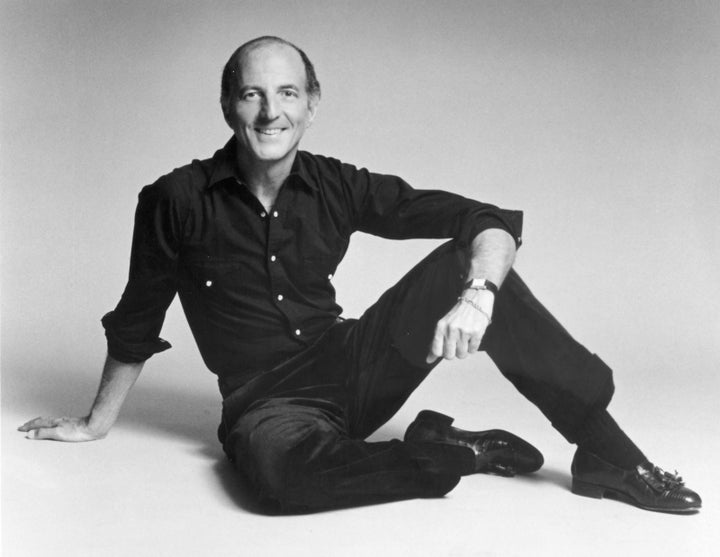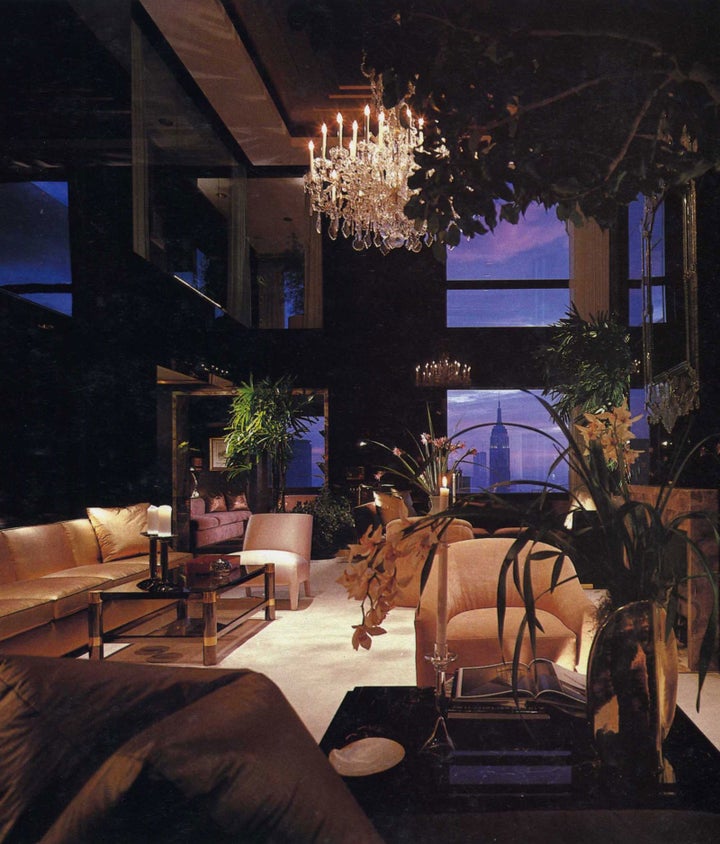[ad_1]
So you’ve been elected president. You’ll soon be living in a landmark mansion that’s been home to some of the greatest leaders in our nation’s history. You’re busy, challenged, stressed — but you’re thrilled to be moving to 1600 Pennsylvania Avenue. Unless you’re Donald Trump.
The president-elect has said he hopes to spend an unspecified number of nights a week in his Trump Tower triplex, his Manhattan home since 1983. And why not? Though the White House has 132 rooms on 18 prime acres, and if it were for sale, might go for $110 million, the Trump Tower triplex, estimated to be worth $100 million, is 10,000 square feet larger, has a front door crusted with gold and diamonds, public rooms literally bathed in 24-karat gold, statues and fountains and mirrored walls and painted ceilings. The cold reality is that, for the president-elect, the White House may well represent…downward mobility.
Trump has good reason to want to bunk in his own bed. He’s said his tower boasts “the finest apartments in the top building in the best location in the hottest city in the world.” And on floors 56, 57, and 58, he’s got the best of the best. The triplex is Trump’s Versailles in the sky, first rate in every way — including its original designer. Take this quiz: Who decorated the Oval Office? Whose design signature is on the Lincoln Bedroom? And the East Room, where state dinners are held — if that party space reflects American greatness, why did Donald Trump, months before the election, offer to build a new $50–$100 million ballroom at his own expense?
Now consider the Trump Tower triplex. Its esteemed decorator had a staff of 125, owned 10 companies, didn’t take a residential job that cost less than $300,000 — Angelo Donghia was considered America’s first superstar designer. In 1983, when Trump cut the ribbon on his tower and moved in, he was still years away from the yacht and the plane and the Trump Shuttle and The Art of the Deal. So Angelo Donghia designing and decorating the triplex didn’t, back then, add to Donghia’s status; it added to Trump’s. But the image of Trump's home that you envision when you close your eyes — the all-gold everything — isn't Donghia's work. Trump took Donghia’s subtle, sophisticated approach and turned it into his version of a showplace — a sunglasses-required vulgarity that Tony Montana and Saddam Hussein would envy.
Angelo Donghia designing the triplex didn’t, back then, add to Donghia’s status; it added to Trump’s.
Donghia died in 1985, when he was just 50. Three decades later, he’s a legend in his profession. His company has survived and prospered. But few outside the insular world of decorating know of him. And, even more remarkably, many distinguished New York design veterans don’t recall Donghia as the designer of the triplex. “Really?” said Mario Buatta, another decorating legend, when asked recently. Joan Kron, a contributing editor of Allure for more than two decades, echoed that response. Suzanne Slesin, who reported on home design for the New York Times for 17 years and wrote about Donghia, paused before offering, tactfully, “A strange disconnect.”
Angelo Donghia wore gray flannel suits custom-tailored by Ralph Lauren. He lived in a townhouse that whispered. His design style — his philosophy — was pretty much the same idea: edit, edit, edit, until the essence of a room was revealed. And yet at Trump Tower he worked for a client who’s been described by Fran Lebowitz as “a poor person’s idea of a rich person.” Their unlikely association is emblematic of Trump's lifelong nervous relationship with status and society, as is his subsequent decision to cover the subtle decor Donghia had created for his stadium-sized rooms with gold, his favorite color. He was the epitome of what Donald Trump once aspired to and the opposite of what he wound up becoming.

Angelo Donghia
Courtesy of Donghia Inc.
In 1981, I wrote a 10-page profile of Angelo Donghia for the first issue of a design magazine called Metropolitan Home. He was exactly what I expected: Impeccably dressed, he sat ramrod straight at his desk, took no phone calls, gave me much more time than he’d budgeted, and made sure I got to talk to hard-to-reach clients like Halston (“At the opening of the Opera Club at the Met, we ordered a magnum of champagne and refused to budge, while people like Ted Kennedy couldn’t get a seat”) and Ralph Lauren (“I was Angelo’s worst client”). And, best of all, he was a gifted storyteller, with a magical success story to share.
Donghia grew up in Vandergrift, Pennsylvania, a tiny town 30 miles from Pittsburgh. Small and not athletic, he worked in his father’s tailor shop on Saturdays to earn money for the movies. He organized supplies. He arranged racks on clothes. When he was just 7, his father let him create a window display for a headless mannequin in a tuxedo.
“I had the idea of an open scene near water, so I put an old piece of mirror on the floor of the window, rested water lilies on the mirror, and placed my display against a black background,” he told me. “When it was finished, it looked like the suit were floating on water lilies. It was like the movies — it was bigger than life, it was exaggeration, and it was spotlit. My father’s reaction was the greatest thing that ever happened to me — he always allowed me to do things and never disagreed with what I was doing.”
At 11, his father handed him a few thousand dollars to redesign the shop. “I didn’t waver for a minute,” Donghia recalled. “I drew it, I chose the colors, and I completed it. The result was perhaps liked by some and hated by others, but that didn’t bother me. What mattered was that I had made something which was really the way I saw it and felt it.”
In high school, where he was president of the student council and ran five other organizations, he sensed that he could be more than a manager — he could lead. Inevitably, he studied at Parsons School of Design in New York, where he was such a standout he was offered a job by noted decorator Yale Burge. Donghia asked for $100 a week. “Will you take $75?” Burge asked. Yes, he would. And he’d skip a final exam so he could start on Monday.
Donghia outworked everyone in the office, became indispensable. After his triumph as designer of the Opera Club at the Metropolitan Opera House — described by a fan as “the finest box of dark chocolates in antique gold wrapping” — he became Burge’s partner; when Burge died, the 37-year-old Donghia inherited the company.
In Yale Burge’s time, decorating was done by society-approved decorators for society clients. Rooms were traditional, tasteful. Designers weren’t celebrities; Burge was a star in a small universe. As Donghia was quick to notice, “Almost no one made any money.”
Burge colored between the lines. Not Donghia: “I knew that what I had wasn’t enough and that my growth had to be through means which weren’t the decorating business. … I told myself that I would be a success. I was fearless. I was willing to fail, and I was lucky. It was that simple.”
His campaign to become a one-man conglomerate began almost immediately. He launched a company to market his fabrics. Sofas, furniture, even gray-flannel ice buckets — he was Martha Stewart before there was Martha Stewart, Ralph Lauren with a greater range of products. After he made public appearances in 200 cities to promote his sheet collection for J.P. Stevens, his name was known to consumers who could only dream of hiring him. At the same time, he designed for mega-clients: hotels, cruise ships, corporations. And he was a sharp businessman: At 40, when he opened a showroom in Los Angeles, he bought the building and became the landlord for other designers.
What drove Donghia? The desire to be rich and famous, for sure. But even more, the desire to see how far and how high he could go. He wanted to make films, open more companies. Why, he might even design a city. “I’d like to start in a small way, with a building or two,” he told me, smiling at his definition of training wheels. “Then a condominium. Then a mini-city. When you enter its walls, nothing would happen in that space except what was permitted to happen — from the way the streets look to the furniture and the lighting.”
“You say that so matter-of-factly,” I said. “Wouldn’t that give you the chills?”
“Certain things might give me a rush, so I feel, ‘My goodness, I never thought of that.' But I feel there isn’t anything that anyone can’t do.”
Courtesy of Donghia Inc.
Donald Trump is the fourth of five children. Born in Queens, which is a bridge and a universe from Manhattan, he learned the real estate business from his father, a hard-to-please disciplinarian whose apartment-building empire in the outer boroughs was worth about $40 million. At 32, he scored his first triumph in Manhattan and promptly turned his attention to a Fifth Avenue project that would bear his name. Who would design and decorate his apartment?
As a designer, Angelo Donghia had a rare sense that style was closely linked to an ever-changing culture. In the late ’70s, his friendship with Halston and other fast-living celebrities gave him a VIP view of disco glitter; at the start of the Reagan years, he was among the first to see that excess should take a richer, more luxurious expression. He’d just completed an apartment for the Laurens on the quietest corner of Fifth Avenue — an environment so unadorned that, someone joked, “Ralph looking out the window was the art.” (A less celebrated client: Bernie Madoff.) He’d regrooved the SS Norway. He’d won early admission to the Best Dressed List.
And so it was, as the movie star in the White House gave rich New Yorkers tacit approval to show their wealth, Angelo Donghia was asked to design Manhattan’s plum project: the triplex of future television star and president Donald Trump.
“In a year, in time for the opening of Trump Tower, the apartment was done, on time and on target,” says Sherri Donghia. “Trump had met his match.”
Sherri Donghia, Angelo’s cousin, was the company’s vice president of design and marketing from 1987, two years after he died, to 2007. An employee who was there at the time told her that Angelo started working for Donald and Ivana when the apartment was just raw space — concrete floors, no windows. Donghia had responsibility for the whole project: the interior architecture, the space planning and the decorating.
Donghia presented his plan to Ivana Trump, and then Tim Macdonald, his associate, executed it. Macdonald met weekly with Ivana and a team of contractors. “Ivana was a fantastic manager and wonderful client,” Macdonald says. And Donald Trump? “Angelo was involved in the conceptualization of the project and not really the execution,” Macdonald told me. “None of those working on the project really had any interaction with Donald Trump.” Maybe it was better that way; the Donghia-Trump team hit every mark. “In a year, in time for the opening of Trump Tower, the apartment was done, on time and on target,” says Sherri Donghia. “Trump had met his match.” When Trump later asked Donghia to do another project, he was told that the only way Donghia would work with him again is if Trump paid 100% up front; that project never materialized. [The President-elect, through a spokeswoman, Hope Hicks, didn’t respond to questions about Donghia or the triplex.]
When the apartment was photographed for a 1985 spread in Architectural Digest, it looked like a logical successor to Donghia’s work, two decades earlier, at the Opera Club. The entrance hall featured dark marble, lacquered walls, and polished bronze railings. The living room was massive, but the chocolate walls, bronze mirrors, and gold leaf ceiling mad it look almost intimate. There was a crystal chandelier that wasn't garish. The banquettes and pillows were covered in metallic gold fabric. There was one sculpture near the window, and it was small. The chimney was framed by recessed cathode-tube lighting. As a room, it was a pure expression of Donghia’s belief that rooms are background for people. “That’s why they’re called living rooms,” he told me.

Donghia's design for a room in Trump Tower, photographed in 1985.
Courtesy of Donghia Inc.
Trump described the triplex's design as “comfortable modernism.” As a builder, he had a different perspective on the apartment — unsurprisingly, the greater achievement was his. “This is a very complex unit,” he told an interviewer in 2014. “If you look at the columns and the carvings … this unit was harder than building the building itself.”
In 1983, Donghia may have been anticipating the city he might design for his ambitious client when he lavished praise on Trump. “He knows exactly who he is, and what he wants,” he told a Town & Country interviewer. “He has very quick judgment and a very definite attitude about what he likes. With Donald, you don't spend a lot of time wondering whether something is right or wrong — it's (a) or it's (b) and that's that. And everything you do for him has to be done ‘great.’”
As good as the triplex looked, the greater triumph was the tower's residential lobby, where Donghia set burgundy mohair sofas against dark green marble walls and bronze deco crown molding. When Trump saw it, Sherri Donghia reports, he was wowed: He called it, unsurprisingly, the best lobby ever.

Donald Trump's penthouse after the renovation
Sam Horine
Donald Trump gets away with many untruths. This isn’t a new phenomenon; before Trump Tower opened, he exaggerated its height. By an act of rhetoric, it would stand 68 floors tall, and his triplex would start at the 66th — a physical impossibility, as there are only 58 stories. Before a press conference in 1980, he urged his architect, Der Scutt, “Give them the old Trump bullshit. Tell them it is going to be a million square feet, 68 stories.” Scutt declined: “I don’t lie, Donald.” A few years later, Scutt told an interviewer for Trump: What’s the Deal? — a documentary that I wrote in 1991 but, because of Trump’s threat of a lawsuit, wasn’t available for 25 years — “When you hear a figure quoted by Trump, divide by two and then by four, and you’re probably closer to the real answer.”
Most articles about the tower cite Trump’s exaggeration of the building’s size as if it were correct. And in every article about Trump’s triplex I’ve seen, Angelo Donghia is named as the designer. That’s not quite accurate. The triplex has been Trumpified — an unnamed designer turned it into a Vegas funhouse. In Jane Mayer’s New Yorker piece about Tony Schwartz, who co-authored The Art of the Deal with Trump, she wrote that the ghostwriter’s impression of the apartment when he started working with Trump late in 1985 was that the apartment looked “unlived-in, like the lobby of a hotel.” Or, perhaps, the lobby of a casino. “All the gilded boiserie was put in after we finished,” says Chuck Chewning, who was creative director of Donghia Inc. for eight years and curated the Angelo Donghia: Design Superstar exhibit at the New York School of Interior Design in 2015. “Ivana hired a casino designer to redo it. There’s very little of Angelo left.”
Donghia’s entrance hall remains intact, but once you get upstairs his clean, luxurious decor has been vulgarized to the point of self-parody.
[ad_2]
